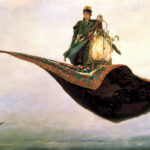What is it like, to have everything at your fingers, and yet to have nothing in your hand?
In the historical fiction novel Heretic Wind, author Judith Arnopp introduces us to Mary Tudor, the daughter of Henry the VIII of England and Catherine of Aragon, and the first English Queen in her own right. The book is a fictionalized biography of Mary I (Mary Tudor, whom John Foxe dubs “Bloody” Mary). The historical character is easy to hate… which is why this book is so wonderful—as Arnopp puts us into Mary’s head, we discover…
Summary of the Heretic Wind by Judith Arnopp
The novel opens in October 1558, a month before Mary’s death. She knows that she is dying, and that her body and mind are failing her. Her courtiers are already lining up to ingratiate themselves with her half-sister Elizabeth, the soon-to-be queen.
Arnopp paints a cruel world of personal power, of the king obsessed with male-line primogeniture controlling the courtiers at his whim; they in turn feel they can control others at theirs.
Mary starts as the child Princess of Wales, the “pearl” of his father and she knows early that she may inherit the throne unless a male prince is born.
As Henry’s desire for a prince is frustrated, he concludes that it is punishment by God for the marriage to Catherine of Aragon (who was wed to his brother Arthur). He wants to be free of that sin, to marry another woman (and beget the male child that he so badly wants). Along with many in the Catholic world, this is of course resisted by both Catherine when she is alive, and by Mary.
As punishment, Mary is thrust down to be a servant to her sister; she is finally welcomed at court after her mother’s death when she signs the papers acknowledging that Henry is the head of church and state, and that the marriage of Henry to Catherine was ‘unclean’ per the Bible.
When Mary ultimately ascends to the throne, the theme of being continually tried by God does not end. Responsibility of state, the need to defend herself against enemies within (such as Elizabeth), to projecting personal power in the medieval world requires her to be more and more forceful. Any instability (like the Wyatt rebellion) is a personal attack against her—both as a monarch and head of state and as a woman.
Her original desire to return England to its religious traditions hardens into persecution of heretics.
Even then, Mary still has some inner doubts about her decisions, such as if she should have spared the heretics that were children. However, any doubt is quickly overcome by her personal makeup that even they were instruments of the devil sent to test her.
As she near the end of her life, Mary is tended to by a handful of her women and servants, one of whom is a child named Anne. Mary tells her story of trials and difficulties to Anne because she wants someone’s company and knows that there is nobody that could give that comfort. Mary feels that she cannot share her story with her attending ladies, as any opinion of her by a commoner is not important and shall not be paid attention to. Anne, in effect allows Mary her final confession of sorts.
Despite initially commenting that Anne was the name of the woman chiefly responsible for ruining her life, over the course of the story, Mary does appear to grow fond of the servant girl. She learns that Anne is of gentile birth, she orders her a gown for and instructs her lady-in-waiting to find a gentler, less trying occupation for her.
Mary believes herself to be a good person, and a good Catholic. In the closing of the book, as she dies, her last thoughts are to protect the ‘good Catholics’ closest to her—Lady Susan and in, an irony that is not lost on Mary herself, Anne.
Thoughts about the Heretic Wind
Aside from Mary’s occasional rages, this is a quiet book, with the first-person narration giving voice to Mary herself.
This to me was the most interesting aspect of the book—history invariably paints “Bloody” Mary Tudor as an evil person. The Mary Tudor of Arnopp’s novel is a very human Mary. Despite being the most powerful person in the realm, one that overcame all sorts of personal challenges and threats, Mary Tudor is also weak and powerless over her fate.
Without excusing or justifying her actions, Arnopp lets Mary tell us her fears and wishes, and show us her internal pains, struggles, and doubts.
I heartily recommend The Heretic Wind to any lover of historical fiction.
Where to buy
You can learn more about Judith Arnopp on her website, https://www.judithmarnopp.com/. Explore her books on Amazon.



